Mrs. Ho retires after 40 years of teaching
Photo by Brianne Reformina
Charles Reed Bishop Learning Center librarian Mrs. Ramona Ho retires after 40 years of teaching. Generations of Maui students will remember her for her expertise in library science and research methods, readiness to help every single student and passion for investigation of the Nisei soldiers of World War II.
Mrs. Ho’s impact on KSM
PUKALANI–– Ramona Ho, high school librarian at Kamehameha Schools Maui, is retiring after 40 years of teaching students. She will be spending more time with her family and continuing her work with the Maui Nisei Veterans Memorial Center.
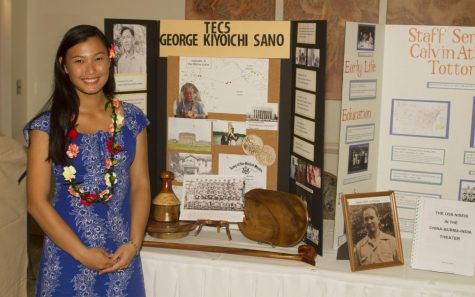
Junior Kayleen Lau shares the research that she did on the life of Nisei soldier George Kiyoichi Sano at a public lecture series, hosted by the Maui Nisei Veterans Memorial Center at the Kahili Golf Course. She completed the research and presentation with the assistance of her adviser, high school librarian Mrs. Ramona Ho.
Students here have benefitted from her efforts. As part of her senior project, junior Kayleen Lau presented a storyboard about the life accomplishments of a Japanese-American Military Intelligence Service veteran from WWII, Army Technician Fifth Grade George Kyoichi Sano. An audience of roughly 70 people attended the leadership series event at the Kahili Golf Course. Former Governor George Ariyoshi spoke there as well.
“Ms. Ho did a great deal of helping me prepare for background research about the Military Intelligence Service before I presented my project publicly. . . .if it weren’t for Ms. Ho’s connections with the Nisei Veteran Center, I probably wouldn’t have gotten the opportunity to share the awareness about the Japanese-American Military Intelligence Service veteran from WWI,” Lau said.
Mrs. Ho is currently a volunteer at the Nisei Center. For decades, she has helped with research and presentations. Her passion for recording history and connecting Maui students to their veteran ancestors, impacted Lau’s choice of senior project.
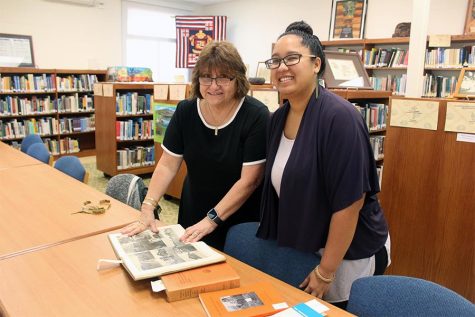
Mrs. Ho and Ms. Kauʻi Podlewski go over plans regarding the future of the Hawaiian room, which is being officially re-named Keaouli on May 16.
Ms. Kau’i Podlewski, librarian assistant, has worked with Ms. Ho for four years.
“[Mrs. Ho] has been the best boss I’ve ever had. She’s had me think more in terms of how to help not only myself but other people and how to better that in servicing students…even outside of the school. Also, how I can help my own family or halau members that I am with. She gave me so much knowledge on how to interact with people,” Ms. Podlewski said.
When Mrs. Ho first came to Kamehameha she was the librarian at the grade school for a year. She had been working as a librarian at Maui Community College, now the University of Hawaiʻi, Maui College.
“So when I came here, it was the first time I had been at a grade school library, and it was really neat because it was the first time I was surrounded by Hawaiian kids,” Mrs. Ho said.
Ramona Ho read to grade school students during “story hour” when the school was still under construction in 2002. The students were surprised when they got an extra visitor at one of the readings.
“It was great being with the kids. The best experience was when I was reading a book about crickets, … so during the middle of the book when I was reading, this cricket comes hopping in, and the kids were just amazed,” Mrs. Ho said.
As the Kamehameha Maui High School grew, Mrs. Ho took the job as the high school librarian in 2003. She also collaborated with Ms. Lesley Pico, the 10th grade US History teacher, on adding to a unit on the 442nd Regimental Combat Team and the 100th Battalion.
Through the years, Mrs. Ho has taught hundreds of students about the World War II troops, as well as the Hawaiian and Maui soldiers who served in the Military Intelligence Service, 442nd RCT and 100th Battalion.
She began at the old Nisei Center archiving artifacts. While there, she ran into so much information on the “Maui men.” For instance, about 12 years ago, she met a nisei man who told the story of being in a foxhole in Italy. The man said that he was covered and protected by a “large Hawaiian man.”
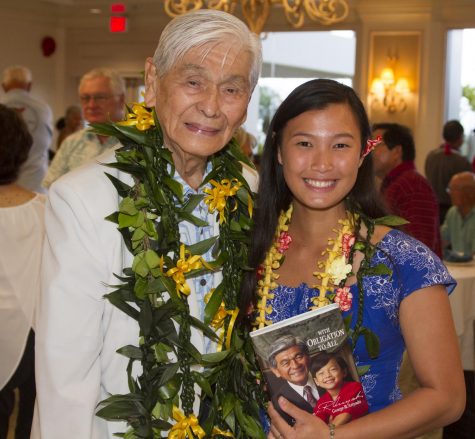
This story made Mrs. Ho curious about Hawaiians who fought in World War II, and since then, she has found about 35 Hawaiians who were part of the 442nd and 100th, most recently, she discovered the story of the Naganuma brothers of Lahaina, who all received medals for their service, including two silver stars and one bronze one.
Their contribution fascinates her. “What would make you decide [to enlist] in the 100th and 442nd, as a Hawaiian, that was so discriminated against, that was treated so badly… as a Hawaiian?” she said.
She passes her expertise on to everyone she encounters.
“When [Mrs. Ho] first came into the [U.S. History] class, I was a bit nervous because of all of the handouts she had given out about the 442nd RCT and the 100th Battalion, but within a couple weeks of learning what those papers held, I eventually realized I had family that had been a part of the OSS being [the] Office of Strategic Services. Mrs. Ho helped me find a part of my heritage that I never knew, so that was pretty amazing,“ Junior Kaylie Ho said
An Olinda Childhood
Mrs. Ho has two brothers and two sisters and grew up in Olinda on her grandfather’s ranch, surrounded by lots of horses and cattle. From a young age, she learned to take on lots of responsibilities through taking care of her family’s animals.
When she was a youngster, Mrs. Ho said that her “earliest memories [were also] in a library” while spending her summers stacking books on shelves at Makawao Library for her mother.
“Reading was a way to travel in your mind, and also I was always a very curious person. For me, reading was a way for me to get answers when you’re looking for answers about different things,” she said.
Finding Her Passion and Purpose
Mrs. Ho experienced many opportunities in high school and college–most of them leading her to pursue the passion that would later turn into her career.
She attended Saint Joseph’s Grade School and Saint Anthony High School along with her two brothers and two sisters. One memorable experience for her was reading the autobiography of Queen Liliʻuokalani.
When she wasn’t at school, she was at her grandmother’s house, across from Makawao Library, and she always had easy access to the resources that were provided there.
In high school, Mrs. Ho found her passion in reading through something simple–helping her mother at Makawao Library until she went to college.
In high school, she noted there was a lack of Hawaiian resources. As a result of these two influences, she turned to Hawaiian studies in college, where she majored in anthropology, the study of human societies and their development, at the University of Hawaiʻi, Hilo. She earned her Bachelor of Science degree in Anthropology, and her career was set. She would also, later, earn two master’s degrees.
She said that she was privileged to study under several significant educators. At UH Hilo, she took ʻŌlelo Hawaiʻi classes from kumu Edith Kanakaʻole, the founder of the Hawaiian studies program there. In the early days, “it was a whirlwind” as she learned from the Native Hawaiian experts in the Hawaiian Homes settlement in Keaukaha.
Later, she recalls fondly taking classes from Dr. James Downes, who, she said, “was one of the best anthropologists in the Pacific.”
Dr. Downes worked with the famous Margaret Mead and went to Japan with General Douglas MacArthur as one of his Pacific advisers.
“I was lucky to have had him in … several classes,” Mrs. Ho said.
She said that students would probably be surprised to know that she put herself through college by working at Dairy Queen and working nights as a cocktail server. She worked the 10 p.m. to 4 a.m. shift in the Pali Room at the Naniloa Hotel, which was frequented by the local “mafia” and 250,000 servicemen from all over the world, who came into Hilo during the annual Rim Pac week for “R and R [rest and recreation].” This was the week during which they would bomb the island of Kahoʻolawe, using it for target practice and destroying its aquifer.
An Eye-Opening Time
In her junior year, she went to Oregon State University through a UH Hilo exchange program, where she would meet her husband, who wanted to be a pharmacist. Mr. Glenn Ho, Mrs. Ho’s husband, had served in the United States Air Force before attending the college where they met.
In college there, Mrs. Ho lived in a sorority house, but she was the only girl from Hawaiʻi accepted into her sorority even though two of her friends from Hawaiʻi had also tried to get in. She said that sheʻs sure it was because of the light color of her skin as compared to her friends.
“[The sorority] was made up of all white women, and it wasn’t until my husband, fiancée at the time, came to visit me at the sorority house that I realized their nature,” Mrs. Ho said.
Mr. Ho is Chinese and Japanese. When Mr. Glenn Ho visited her at the sorority house, the women refused to let him in.
“[The girls] told me that he couldn’t come in because he wasn’t American, and I was furious because these girls were so naïve [that they couldn’t] see he was wearing an American Air Force jacket,” she said.
Mrs. Ho had never experienced racism until going to the U. S. Mainland. She said there was another time when she and her friends from Hawaiʻi “stirred the pot” when they decided to have fun playing ʻukulele, singing and dancing around. Her sorority sisters were surprised to see them being foolish and “inappropriate,” Mrs. Ho said.
“It’s funny today because I think of how naïve these girls were, but back then, it frustrated me and angered me to even imagine how society acted,” she said.
The following year, she left her sorority house but still continued to attend school. She would graduate in 1977 from UH Hilo.
“I thought I had everything planned out, but then, I looked back and found that maybe I wasn’t doing what I really wanted to do,” Mrs. Ho said.
“Research, Research, Research”
After getting her first graduate degree, (by that time, she was married to the now-pharmacist Mr. Ho), she immediately found herself putting her research skill to use. Mr. Ho was doing his residency at Queen’s Hospital, and at the time, medicine was just learning that drugs crossed through the placenta during pregnancy. It became apparent that there was a need for a drug information center for women “because doctors were giving women drugs when they shouldn’t.”
Working with the March of Dimes and the top OB-gyn doctors at Kapiʻolani Hospital, she sought out teratogenic studies right out of graduate school, and through her “research, research research,” she looked into the top 100 most-prescribed drugs of the day. She was looking for information about the effects of drugs on fetuses in utero.
As a result, she was sent to California to work with doctors and nurses in the ‘80s.
“I realized what doctors didn’t know. It was amazing; it was scary,” she said.
Then, she earned her teaching certificate, which led her to dive right into her school librarian career
A Librarian’s Life
Mrs. Ho returned to Maui and worked at Maui Community College, Kihei School and Maui High School. She recognized that the typical local library staff had a definite hierarchy.
“The library techs [assistants] in Maui were usually local women. The librarians were usually women from the Mainland, so there was always this line [between positions for local women and positions for Mainland women]. So when I graduated and came home and my first job was at the Wailuku library, I can remember the techs looking at me and just being in awe that I had crossed that line,” she said.
As a librarian, she began to do a lot of research on the Nisei 442nd Regiment Combat Team (RCT) and 100th Infantry Battalion, Japanese-American military groups who fought in World War II.
Mrs. Ho discovered that Hawaiians were a part of the Nisei military groups, and some of them are relatives of students at Kamehameha Schools Maui.
“It’s amazing how you could find your relatives from a long time ago in a war or battle that you never thought they fought in,” she said.
Thanks to Mrs. Ho’s research, KSM’s Charles Reed Bishop Learning Center has built up a large history section, including many books on the 442nd and 100th Battalion.
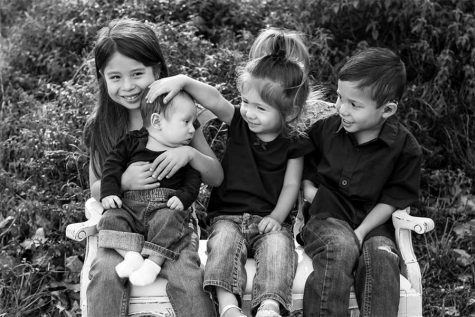
Mrs. Ho’s grandchildren. She says that her children and grandchildren are her “greatest accomplishments” in her life.
Life after Libraries
Books on the 442nd infantry regiment and World War II are piled on Mrs. Ho’s desk; however, she does not let them block the pictures of her family, which surround her.
After all the hours of WWII research and discovery, Mrs Ho says her “greatest accomplishment is raising [her] children.”
To her, family is at the core, and they will be her main focus in her life after retirement. She keeps them near and dear to her heart, especially her two children.
“Those are the two things that will be here after the day I die,” Mrs. Ho said.
Matthew and Malia Ho were born and raised on Maui but currently reside on the mainland and the Big Island with families of their own.
Her son, Matthew, “has always been [a] local boy,” she said. “He has tattoos and long hair-he’s more of a moke than a doctor,” she laughed, proud of the way her son remains true to his local culture while still being a successful professional.
Matthew currently works in Santa Rosa with the Veterans Administration as a Doctor of Pharmacy. He also has Mrs. Ho’s four grandchildren: Ninel, Kawika, Arianna, and Kapono. Mrs. Ho hasn’t seen all four together in six months.
“He’s an okay doctor,” she continued jokingly, but in her eyes, her son is more importantly “a really good father, [who] loves his kids.”
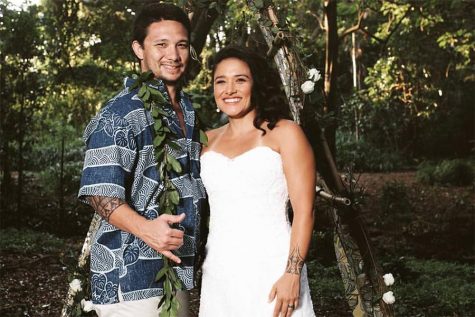
Matthew and Malia Ho
Matthew’s wife comes from a Mexican background, so his children are growing up in a Spanish-speaking household and attend a Spanish language immersion school.
“They have some pidgin English in there from their dad,” Mrs. Ho said. “They speak in Spanish and say ‘choke’ or ‘pau’ [too].” Whenever Mrs. Ho tries to speak Spanish, her grandchildren “always correct [her] saying ‘no tutu.’”
Mrs. Ho doesn’t see language as a barrier. When she does see them, she makes it a priority to spend as much time with them as she can, Reading to them is a favorite activity.
Mrs. Hoʻs daughter, Malia, is currently a Big Island attorney with the Department of Corporation Counsel.
After retiring at the end of this school year, Mrs. Ho plans to stay on Maui and continue her research with the Nisei Veterans Memorial Center; however, she also plans on taking time off to travel and visit her family on both the U. S. Mainland and the Big Island.
She said, “I want to spend time with my grandchildren, [so] for now, it’s them.”


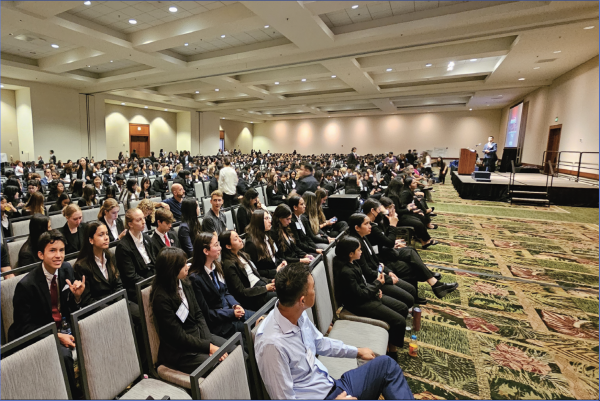
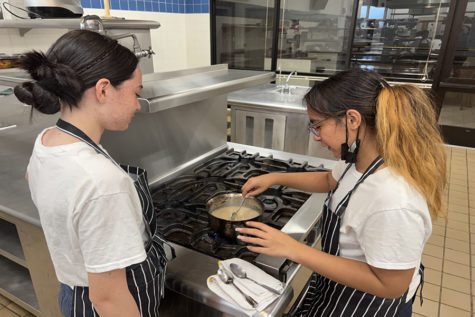
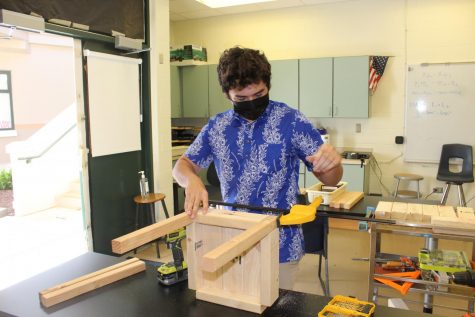
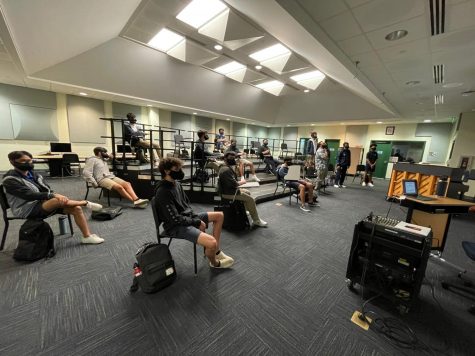
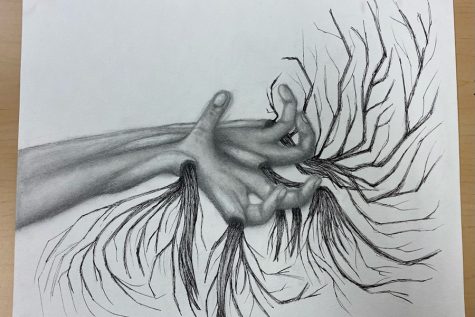
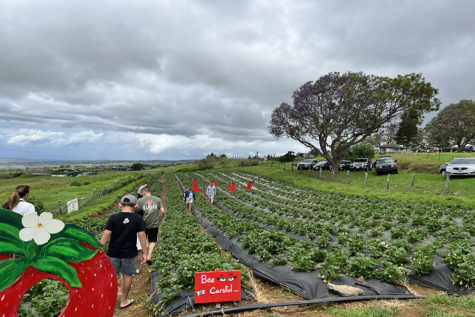
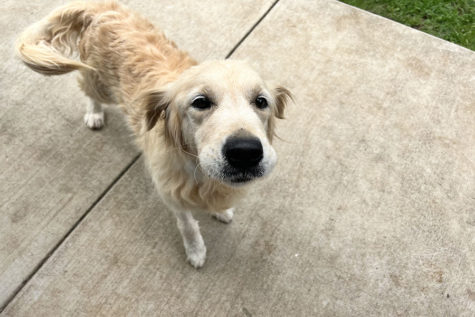
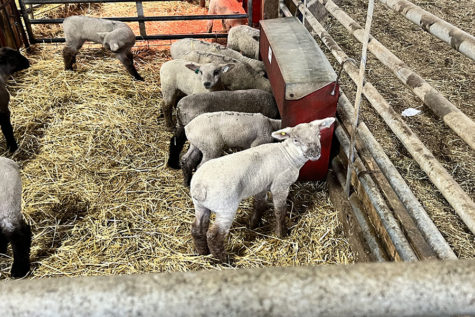
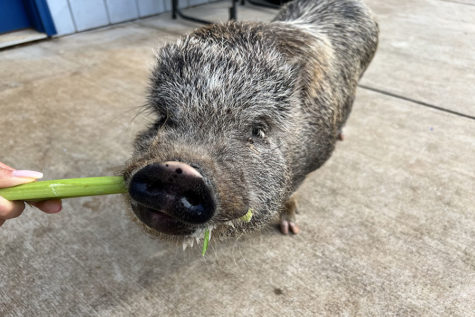
Michelle Minero • May 25, 2018 at 7:41 am
Congratulations Ramona, aka Tutu!
You are a tough act to follow! I know your students past and present will miss your guidance, but your grandchildren will love seeing you more often!!
Noelani Yatsushiro • May 16, 2018 at 1:08 pm
Mahalo e Mrs. Ho! You’ve been a part of my life for over 20 years. Go, Sabers! Go, Warriors! I appreciate your guidance and friendship.
Kuba • May 16, 2018 at 9:31 am
Maikaʻi on Mrs Hoʻs story, i didnʻt know of her Life outside of KSM. What a varied and rich Life!! May Ke Akua continue to Bless her in her new endeavors n Retirement!! Aloha e Ke Akua, for Mrs Hoʻs legacy touching the future through those she has touched! Amene, Amene, Amene!!
Kimo • May 16, 2018 at 5:47 am
Great article. Akira was in the 442. He was wounded in Italy. He also was a jockey for the Baldwin’s back when we had the race track.